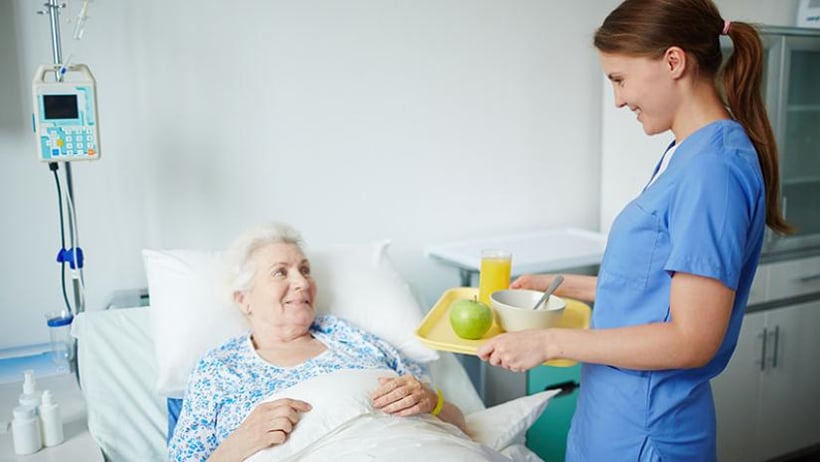
As cases of COVID-19 continue to appear throughout Canada, it is becoming increasingly evident that the coronavirus does pose a serious threat to vulnerable populations, particularly those in long-term care. As of late, there have been several outbreaks in long-term care facilities, including some deaths. In response to the growing threat to our most vulnerable, organizations that work with vulnerable people need to put extra measures in place to prevent the spread of COVID-19. Here are some ways that you can keep the staff and the vulnerable people in your premises safe.
Implement new measures
Increase testing and screening: Long-term care facilities need to be implementing a strict testing and screening regimen. All staff, food workers, residents, visitors, contractors or anyone else entering the premises must be screened for COVID-19. This includes being assessed for symptoms and questioning about known exposure to COVID-19.
Install barriers: Workers that are at the entrance to the premises and conducting testing and screening should be protected with a physical barrier such as a plexiglass screen. This not only protects the staff behind the screen but those workers who are entering the premises to work. If this is not possible, the worker should be provided with masks and other personal protective equipment (PPE).
Restrict access: Access to residents by non-residents and family members should be restricted. Access points to the building should also be minimized. This will make it easier for staff to conduct testing and screening of anyone who is entering the premises. This will also allow for staff to keep an accurate headcount of who is in the building at any one time.
Restrict staff locations: The staff that works directly with the people in the care facility need to be restricted to working at only one location. The same goes for any food handlers serving people, and those working in the kitchen. By doing this, you reduce the chance of staff contracting COVID-19 at another facility and bringing it into yours.
Hire more staff: By restricting staff to working only at one location, many long-term care facilities will find themselves with fewer staff on hand. Not only is this risky for the care of those in the facility, but it puts other preventative measures at risk of not being performed up to standards. For example, if there are fewer kitchen staff working, food safety measures and protocols could be underperformed or not performed at all, putting vulnerable people at risk of food-borne illness. In the midst of the threat of COVID-19, long-term care facilities do not need to be dealing with food-borne illness outbreaks. More staff should be hired to maintain protocols and any new Food Handlers that are hired should be trained in food safety and obtain their food handler certification.
Maintain protocols and operations
Uphold cleaning and sanitizing measures: Measures for cleaning and sanitizing have been increased during the COVID-19 pandemic. These measures must be maintained by staff at all costs. Frequently touched items must be cleaned and sanitized, especially items that are normally cleaned but not sanitized under usual circumstances.
Use personal protective equipment: Staff should be provided with personal protective equipment such as masks and gloves and trained on how and when to use them. Changing gloves is of particular importance as they are often contaminated and staff can contaminate their hands when changing gloves. For Food Handlers that are serving food to residents, ensure that they wear gloves whenever possible. If gloves are not available, ensure that serving utensils are used, such as tongs. Currently, food workers are not encouraged to wear gloves during food preparation, but rather only when handling ready-to-eat foods.
Exceed hygiene standards: All workers on the premises, including those who work with food, must uphold stringent hygiene standards. Staff should be re-trained on how and when to wash their hands, coughing and sneezing etiquette, and the importance of not touching their face whilst working.
Ensure physical distancing: While it is not always possible within tight quarters, physical distancing between staff and the people in their care should be done whenever possible. Any staff that are working in the kitchen, handling food, or delivering food to residents must also maintain physical distancing protocols. This is essential to preventing the spread of COVID-19 among residents and staff.
Report illnesses: Any staff that works within the premises, including administration, support workers and food handlers must follow the requirements for reporting illnesses. Staff need to be trained on the signs and symptoms of COVID-19 and what to do if they think they have the virus. Staff should also be instructed on the appropriate actions to take should they fall ill at home, or if they fall ill while at work. Dealing with sick employees on the premises requires immediate and proper action.
Stay up-to-date
While this list contains essential ways to prevent the spread of COVID-19 in long-term facilities, it is not an exhaustive list. The COVID-19 pandemic is constantly evolving and new measures are being advised all of the time. Information is also being updated about the nature of the virus and what organizations can do to combat the spread of the virus. The Canadian Institute of Food Safety continues to provide up-to-date information on COVID-19 as it becomes available. You can also visit the CIFS Membership page for COVID-19 resources that are full of essential information for enduring the pandemic.





